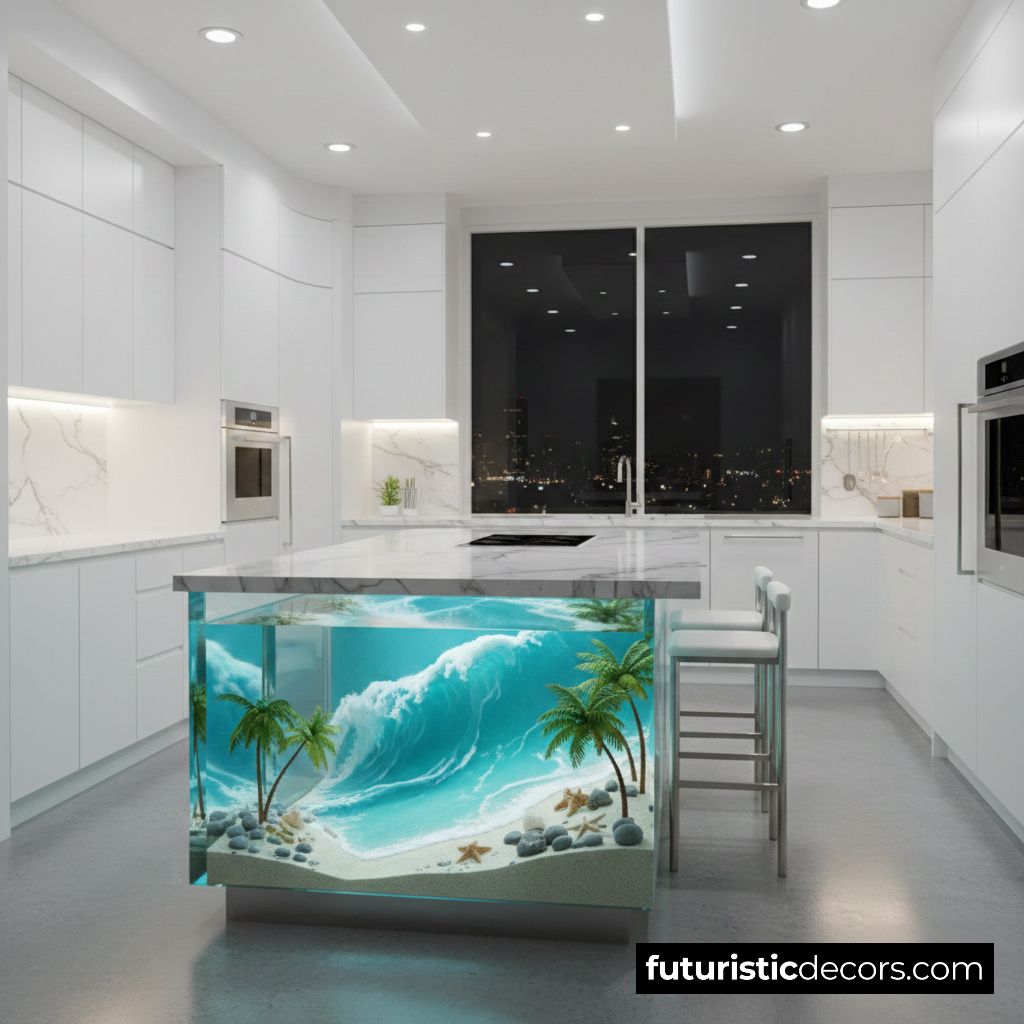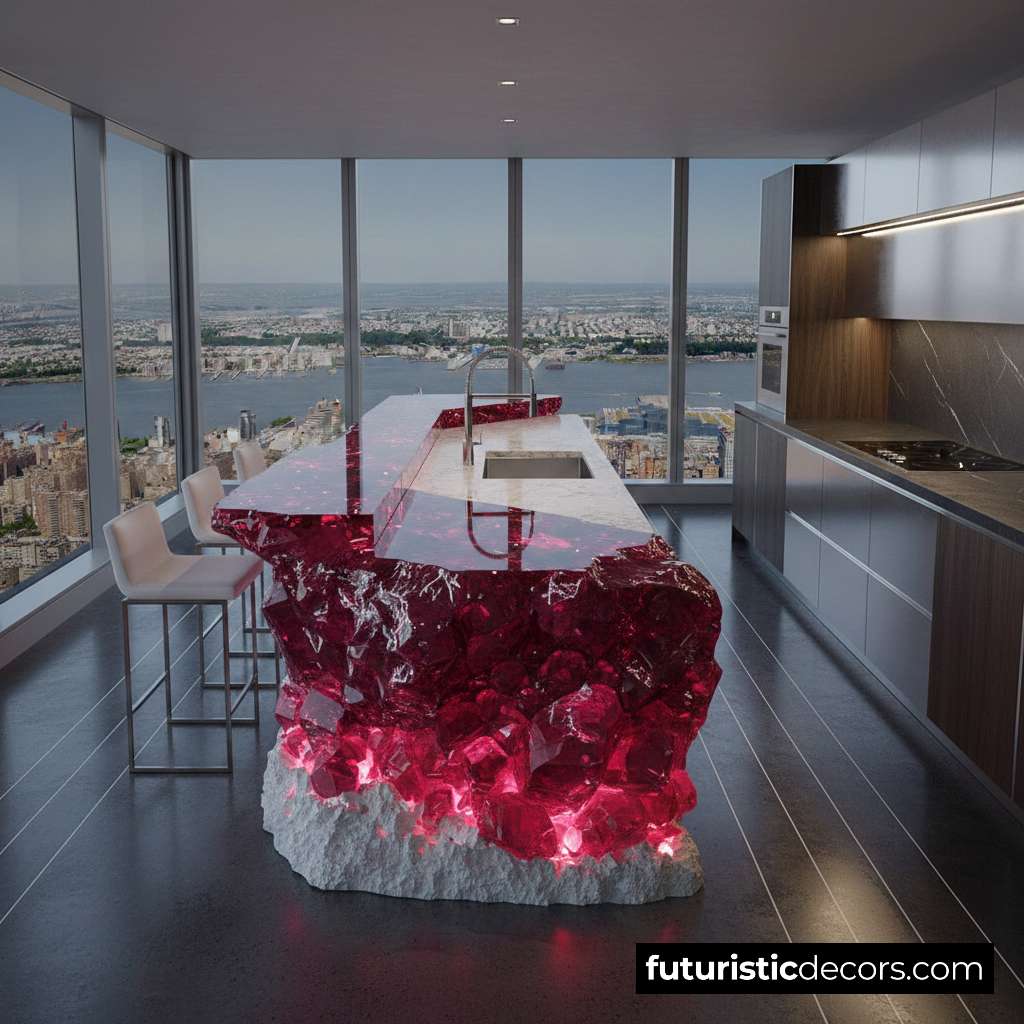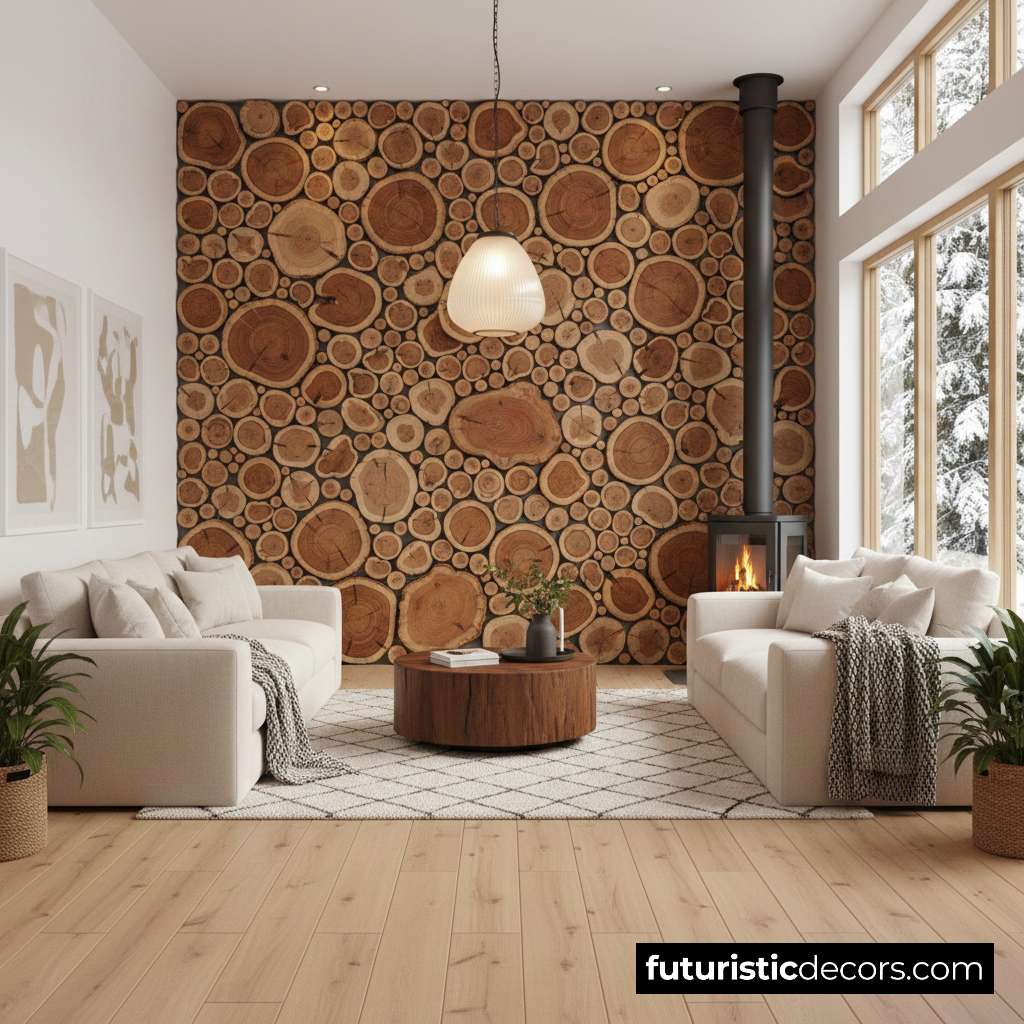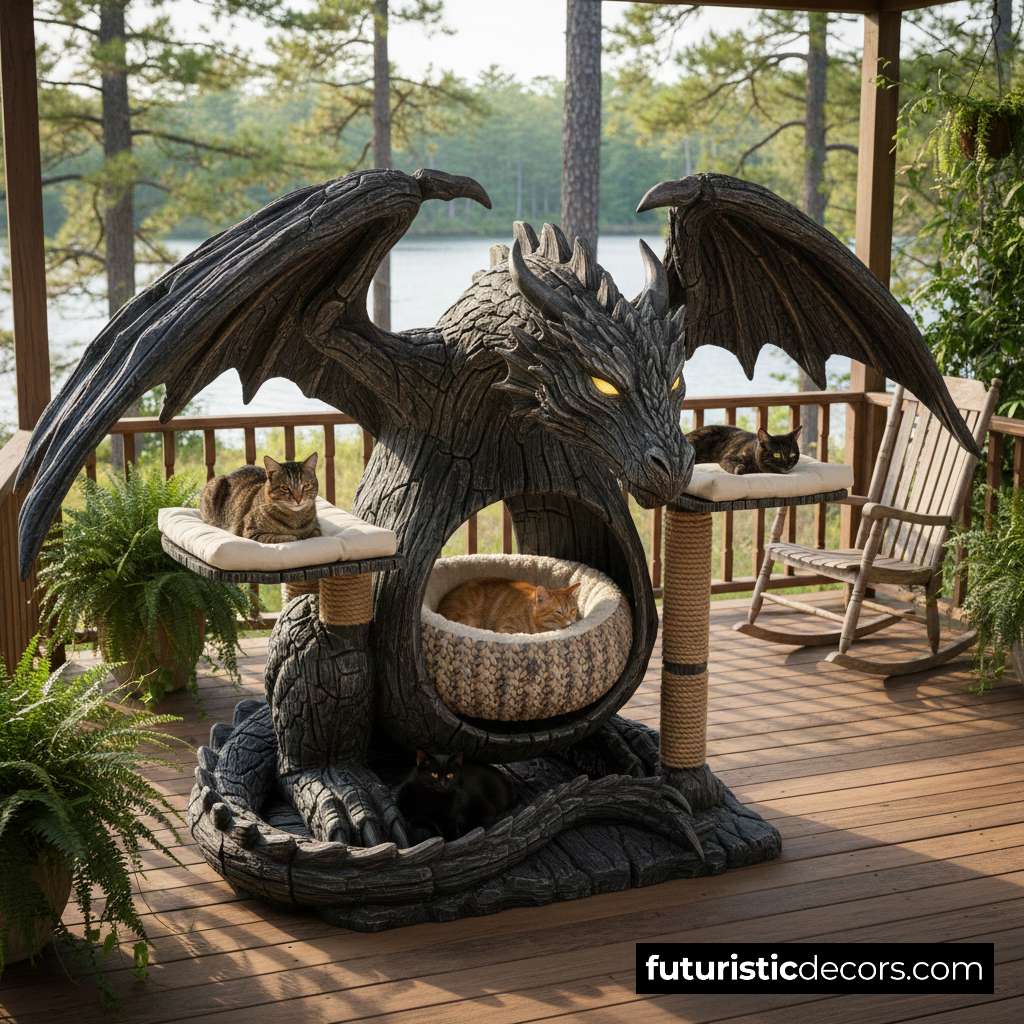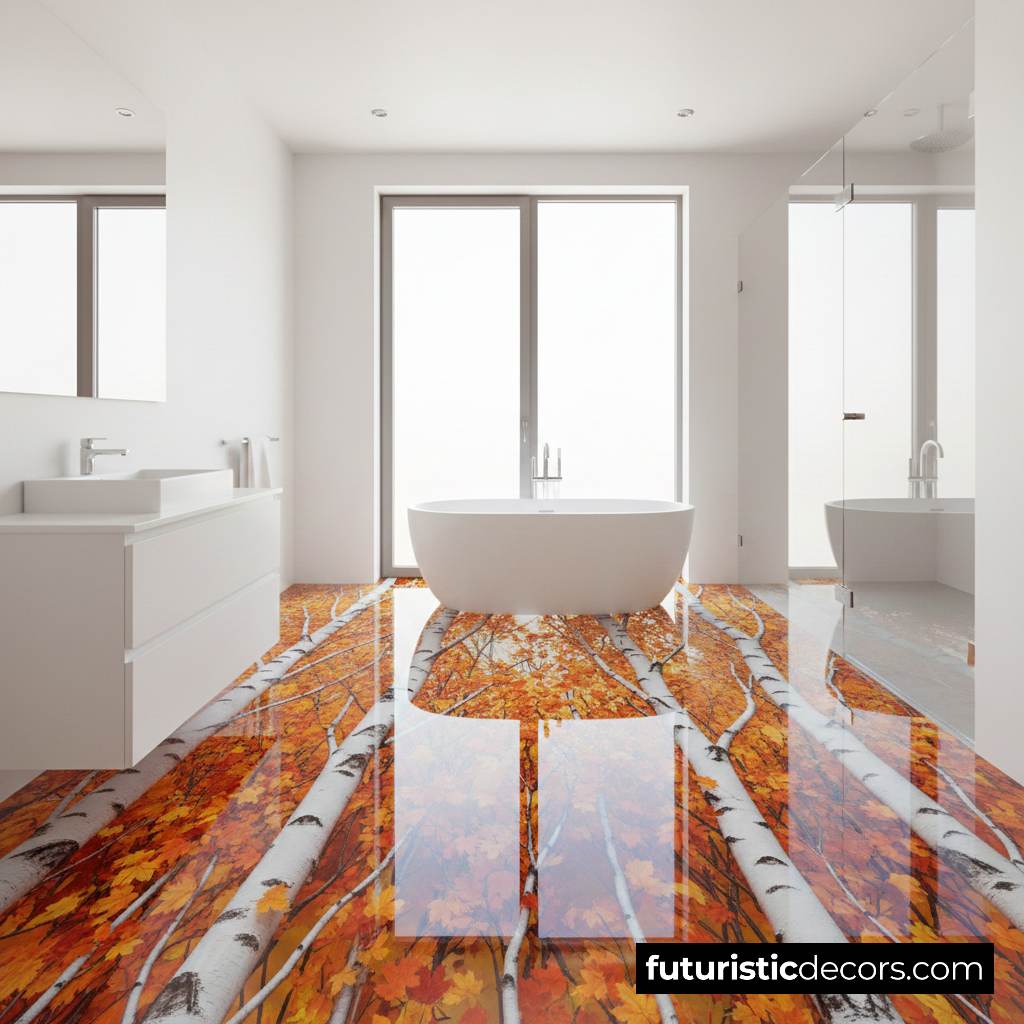Imagine stepping into your kitchen and being greeted by the gentle sway of tropical fish gliding beneath rolling waves—right in the heart of your culinary workspace. A Pirate ship aquarium kitchen island does exactly that, merging high-seas adventure with everyday cooking. This article explores how transforming your kitchen with a pirate-themed island that doubles as a living aquarium can elevate both form and function. We’ll guide you through the concept, design essentials, installation steps, maintenance routines, budgeting considerations, and even real-world inspirations, ensuring you’re fully equipped to chart a course toward a one-of-a-kind culinary oasis.
By blending maritime aesthetics with cutting-edge aquarium technology, you not only gain additional counter space and storage but also an immersive sensory experience that delights guests and soothes the soul. Whether you’re a seasoned renovator or a first-time home improver, our detailed breakdown will help you plan, design, and maintain your very own pirate ship aquarium kitchen island—turning your cooking station into the ultimate conversation piece.
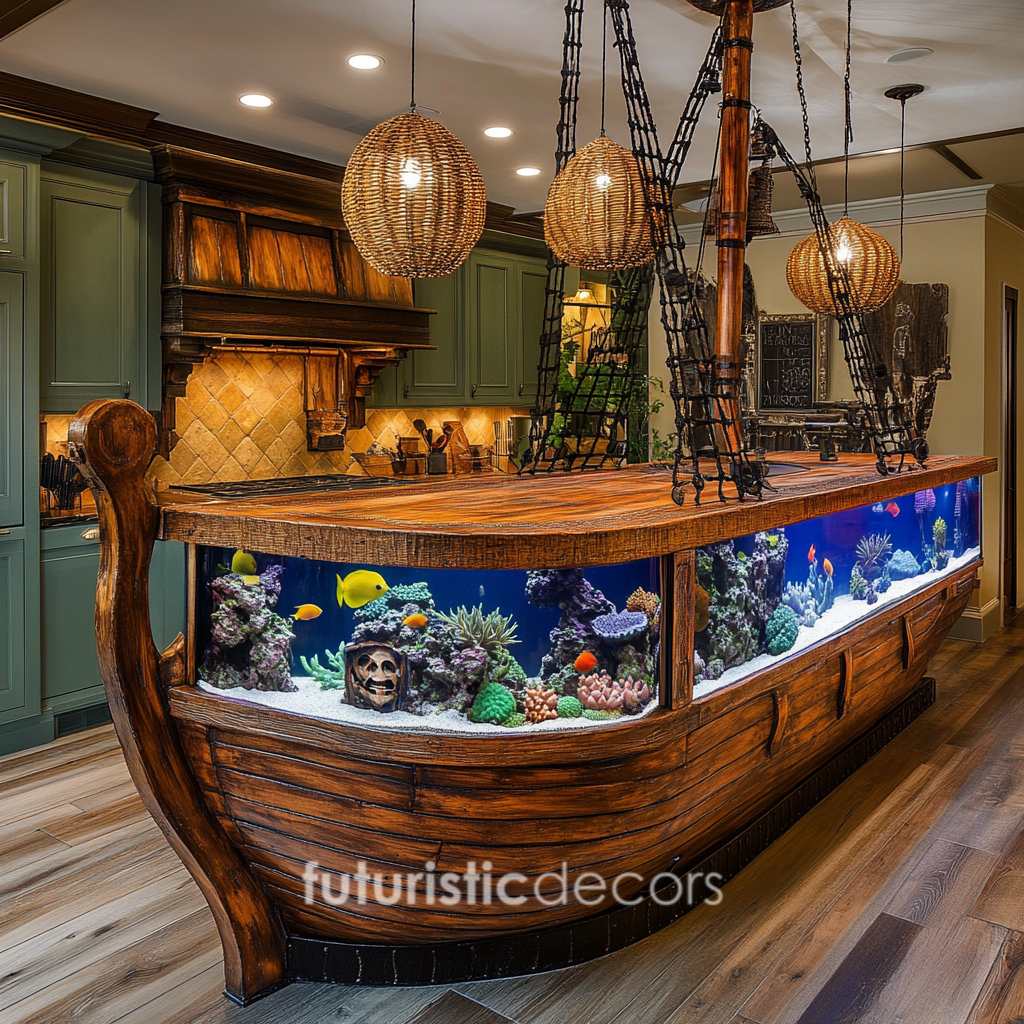
Concept Explained: Pirate Ship Aquarium Kitchen Island
A pirate ship aquarium kitchen island is a multifunctional piece of bespoke furniture combining a kitchen island’s workspace with an integrated aquarium shaped like a swashbuckling vessel. At its core, it functions as any other island: providing prep surfaces, storage cabinets, and seating. Yet its pièce de résistance lies in an aquarium tank crafted into the “hull,” complete with curved glass panels, nautical embellishments, and often a mast or sail element rising above the countertops.
This fusion of design and utility brings together carpentry, marine engineering, and interior décor. The skeleton is built from sturdy, waterproof materials—such as marine-grade plywood coated in epoxy or stainless steel framing—to support the weight of water and aquatic life. Within this shell, a custom aquarium tank is installed, complete with filtration, lighting, and climate controls. Above deck, the countertop integrates seamlessly, allowing for meal prep or casual dining, while below, fish, corals, and aquatic plants thrive—offering a dynamic, ever-changing vista in your kitchen.
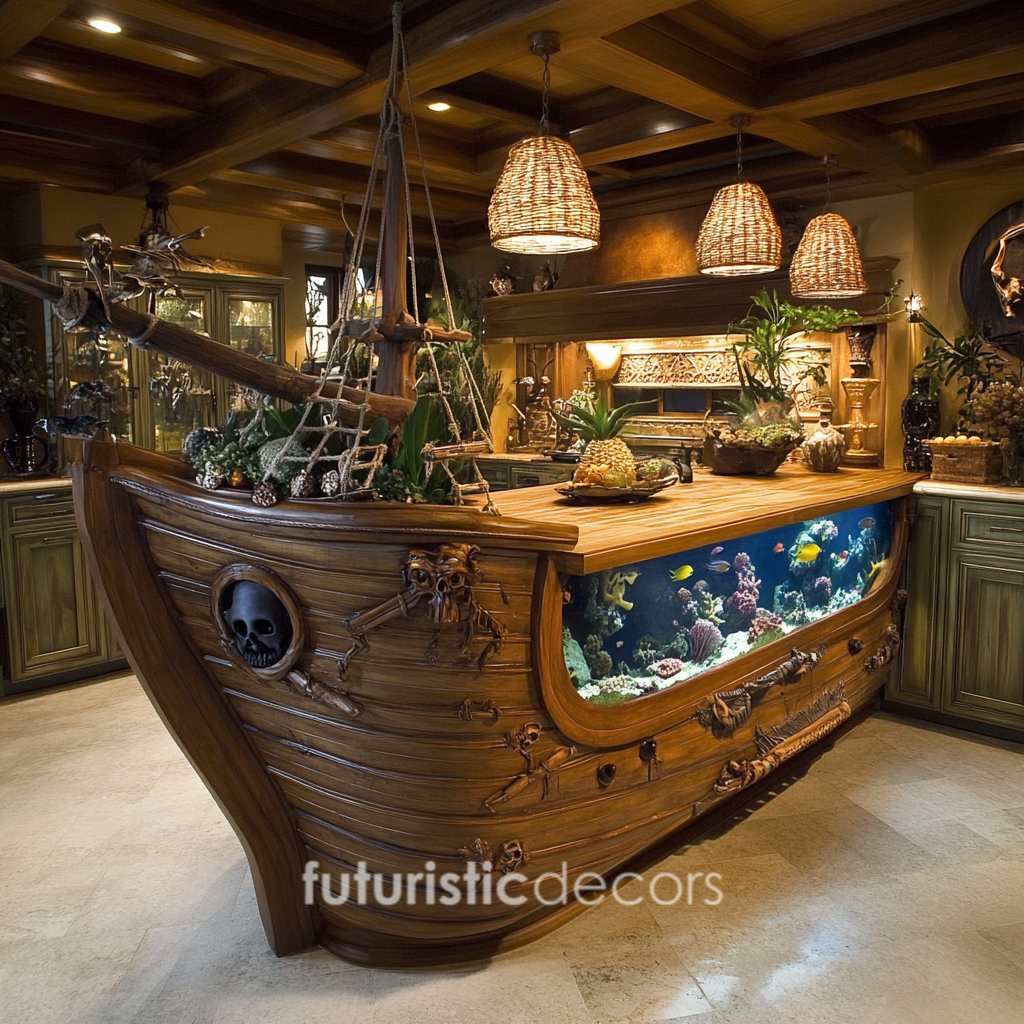
Pirate Theme Appeal
Why pirates? The swashbuckling lore of hidden treasures, secret coves, and world-spanning voyages taps into our collective imagination. Incorporating a pirate ship motif infuses your kitchen with a sense of escapism—transforming routine tasks like chopping vegetables or washing dishes into opportunities to daydream of ocean voyages. Rich wood finishes, weathered brass accents, and authentic rigging details evoke 17th-century galleons, while subtle distressing and patina lend an air of authenticity.
Moreover, the theme is versatile: you can opt for a dramatic, theatrical centerpiece reminiscent of a pirate flagship, complete with crow’s nest shelves and rope railings, or choose a subtler homage, such as a scaled-down hull silhouette and gentle nautical motifs. Complementary décor—like treasure-map tile backsplashes, barrel-style bar stools, and barnacle-textured cabinet handles—reinforces the narrative without overwhelming the overall kitchen aesthetic. In doing so, your pirate ship aquarium kitchen island becomes more than just furniture; it becomes the focal point of a carefully curated, story-driven space.

Functional Fusion: Aquarium Meets Kitchen Island
At first glance, pairing an aquarium with a kitchen island might seem purely decorative—but the blend offers tangible benefits:
- Enhanced Ambiance: The ambient lighting from aquarium LEDs adds a soothing glow to your kitchen, perfect for evening gatherings or late-night meal prep.
- Stress Reduction: Numerous studies document the calming effect of watching fish swim and water ripple. Installing an aquarium in your busiest living space can reduce stress and improve focus.
- Optimized Use of Space: Instead of dedicating a separate area for an aquarium, combining it with a kitchen island economizes square footage—especially valuable in open-plan homes or apartments.
- Conversation Starter: Guests won’t just comment on your cooking skills—they’ll be captivated by the living exhibit at the center of your culinary domain.
Functionally, the island retains all traditional roles: chopping, serving, storage, and seating. Smart design ensures that aquarium components—like pumps and filters—are concealed within the base cabinets, accessible via removable panels for maintenance. Meanwhile, countertop materials are selected for durability and water resistance, making cleanup a breeze.
Design & Materials: Pirate Ship Aquarium Kitchen Island
Crafting a convincing pirate ship requires attention to both structural integrity and authentic aesthetics. Common materials include:
- Marine-Grade Plywood: Coated with multiple layers of epoxy resin to resist moisture, ideal for the hull’s frame.
- Stainless Steel & Aluminum: Used for internal support brackets and tank framing; corrosion-resistant in high-humidity environments.
- Tempered Glass or Acrylic Panels: For the aquarium walls—acrylic offers superior impact resistance and clarity but can scratch more easily; glass is more scratch-resistant but heavier.
- Epoxy Resin Finishes: Applied over wood for a glossy, waterproof surface that mimics aged planks but remains easy to clean.
- Brass & Copper Accents: Barnacles, porthole frames, and rivets forged from brass lend historical authenticity and develop a natural patina over time.
- Natural Wood Veneers: For exterior planking effects, treated with marine varnish to withstand humidity.
Designers often incorporate curved panels to simulate a ship’s bow and stern, with below-deck storage disguised as cargo holds. Countertops can be butcher block for warmth or engineered stone for durability; edges may be contoured to resemble the rolled gunwale of a vessel. Overhead, a mast structure can double as a pot rack, while sails fabricated from heavy canvas acrylic add drama without obstructing sightlines.
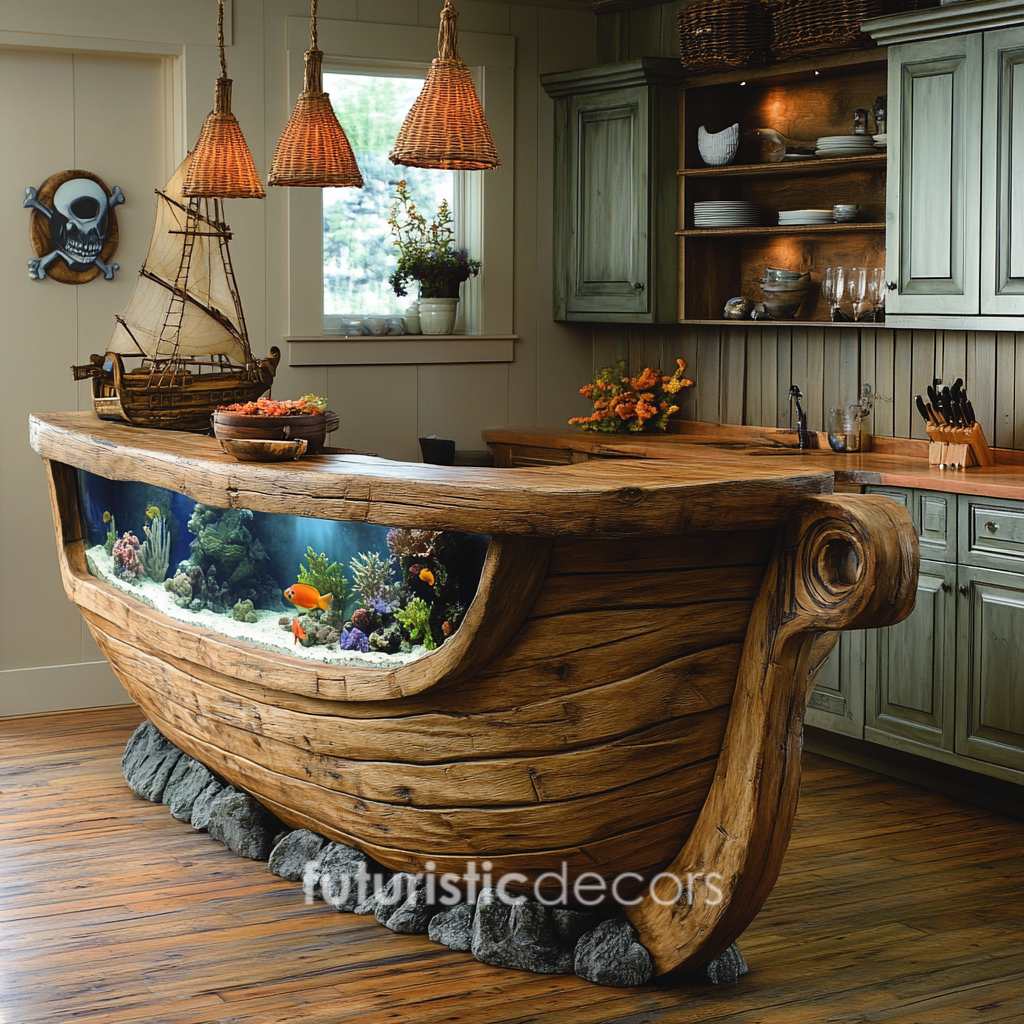
Aquarium Mechanics: Life Below Deck
Beneath the culinary surface lies a fully functional aquatic ecosystem, engineered for both fish health and minimal disruption to kitchen workflows:
- Tank Capacity & Dimensions: Ranges from 100 to 250 gallons for a residential island. Custom dimensions ensure the aquarium fits snugly within the hull’s contours.
- Filtration Systems: Canister filters or sump systems are concealed in adjacent cabinetry, providing mechanical, chemical, and biological filtration. Saltwater systems often incorporate protein skimmers and refugiums.
- Lighting: LED fixtures mimic daylight cycles, adjustable for intensity and color temperature. RGB LEDs allow dramatic night-time effects, such as “moonlight” blue glows.
- Heating & Cooling: Submersible heaters maintain tropical temperatures (around 76–82°F), while chiller units may be necessary in warmer climates to prevent overheating under kitchen lights.
- Water Movement: Wave-makers or powerheads simulate ocean currents, benefiting saltwater corals and active fish species. Low-noise models ensure kitchen activities aren’t disturbed by buzzing pumps.
Equipped with smart sensors, you can monitor pH, temperature, and salinity from your smartphone—receiving alerts if any parameter drifts beyond safe ranges. This integration ensures your pirate crew (fish and invertebrates) thrives without constant manual checks.
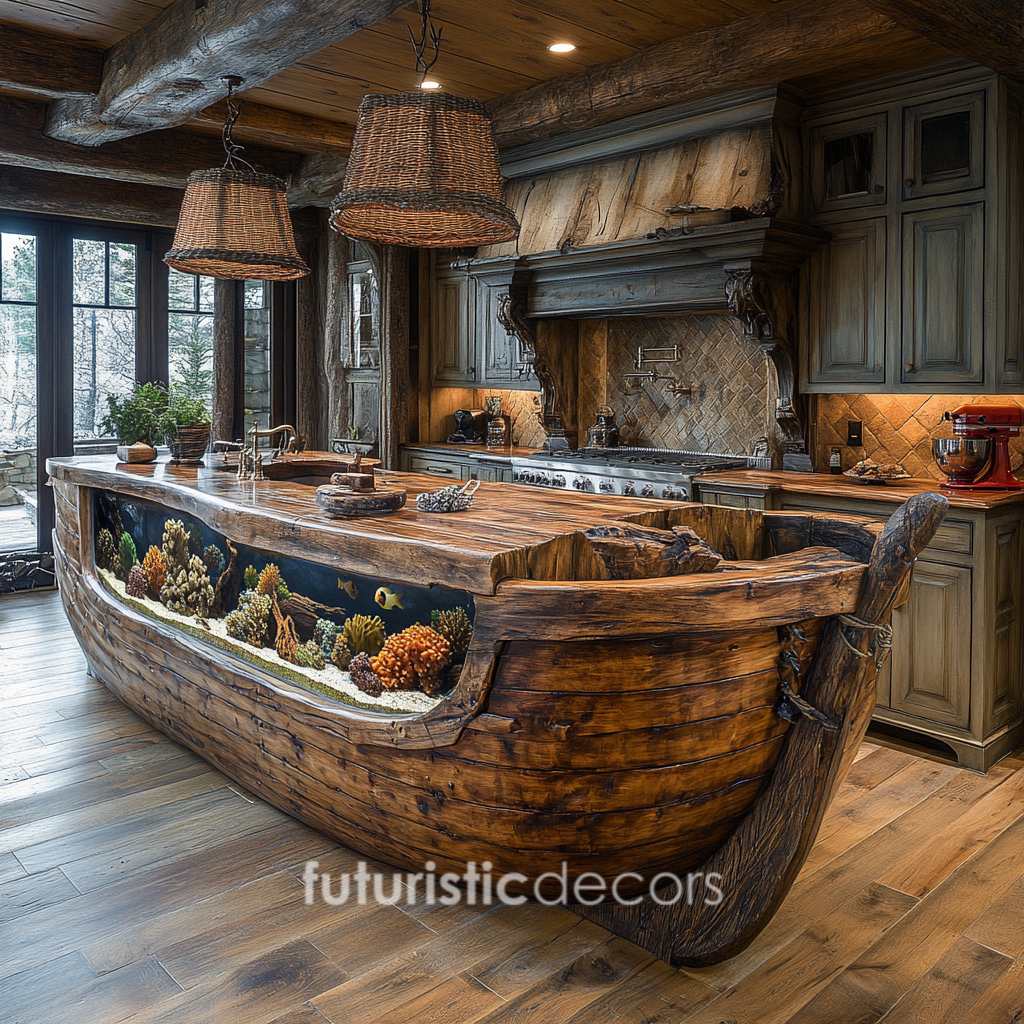
Spatial Integration: Charting Your Kitchen Layout
Incorporating a pirate ship aquarium kitchen island demands careful planning to maintain functional flow:
- Work Triangle Considerations: Ensure the sink, refrigerator, and cooktop remain within an ergonomic triangle. Position the island so it doesn’t obstruct pathways between these zones.
- Clearance & Traffic Flow: Maintain at least 36–48 inches of walkway around the island. Allow extra buffer space on the side where aquarium panels protrude.
- Sightlines & Lighting: Place the island where natural light complements aquarium lighting without causing excessive algae growth. Overhead pendants can highlight the island’s design and draw the eye to aquatic life.
- Seating & Social Zones: Bar-height counters on the opposite side of the tank provide seating without risk of splashing water onto guests. Consider stools with swivel bases for easy movement.
- Proximity to Utilities: Position near existing water lines for aquarium top-offs, and close to dedicated electrical circuits for pumps and lighting. Pre-planning reduces the need for unsightly extension cords or exposed piping.
By treating the island as both a culinary and entertainment hub, you create a seamless integration that feels intentional rather than forced.
Installation Guide: Pirate Ship Aquarium Kitchen Island
Building and installing a pirate ship aquarium island is a multi-stage process:
- Design Consultation: Partner with an interior designer and aquatic specialist to finalize dimensions, materials, and fish-species selection. Use 3D renderings to preview the end result.
- Structural Reinforcement: Verify that floor joists can support upwards of 2,000 pounds (island plus water). Reinforce with steel beams or sistered joists if necessary.
- Cabinet Fabrication: Construct the hull frame off-site using moisture-resistant plywood and epoxy coatings. Pre-cut openings for tank panels, plumbing access, and service hatches.
- Aquarium Tank Assembly: Install tempered glass or acrylic panels into the hull cavity. Seal edges with silicone rated for aquarium use. Pressure-test the tank for leaks before final assembly.
- Plumbing & Filtration Setup: Fit canister filters, sumps, and drains into adjacent base cabinets. Run concealed PVC lines to the aquarium inlet and overflow systems. Include easy-access valves for maintenance.
- Electrical Integration: Install GFCI-protected outlets dedicated to pumps, lighting, heaters, and controllers. Conceal wiring within the island’s frame, maintaining clear pathways for inspection.
- Exterior Finishing: Apply wood veneers or epoxy in layers, distress edges for authenticity, and install brass portholes and decorative hardware. Seal all exterior surfaces with marine varnish.
- Countertop Installation: Position butcher block or stone countertops, fastening them to the island’s top frame. Seal seams to prevent water ingress.
- Aquascaping & Stocking: Add substrate, live rock (for saltwater), or decorative elements such as miniature treasure chests and shipwreck motifs. Cycle the tank water, test parameters, then introduce fish gradually.
- Final Inspection & Handoff: Verify all systems run quietly and efficiently. Provide homeowner training on basic aquarium care and island maintenance.
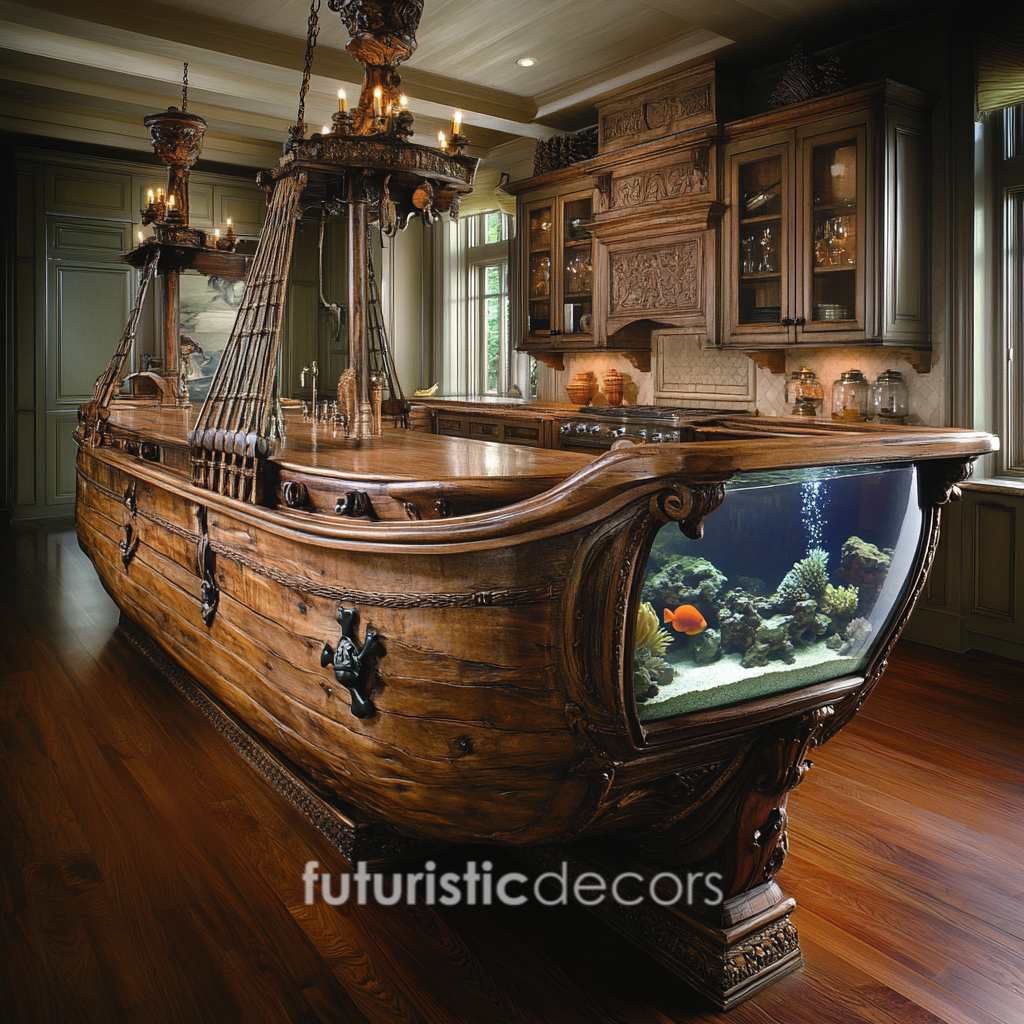
This phased approach minimizes surprises and ensures a smooth transition from blueprint to a fully operational kitchen centerpiece.
Maintenance & Care: Pirate Ship Aquarium Kitchen Island
Keeping both your kitchen and aquarium in top condition requires regular attention:
Daily Checks: Observe fish behavior, ensure filters and pumps are operating quietly, and wipe down any minor spills on countertops immediately.
Weekly Tasks: Test water parameters (pH, ammonia, nitrite, nitrate), change 10–15% of the aquarium water, and clean glass panels inside with a non-toxic magnet cleaner.
Monthly Upkeep: Replace filter media, inspect silicone seals for wear, and trim live plants or clean decorations to prevent algae buildup.
Quarterly Deep Clean: Schedule a professional service to dismantle pumps for thorough cleaning, recalibrate sensors, and check all electrical components for corrosion.
Kitchen Maintenance: Reapply food-safe sealers to butcher block counters annually, polish brass fittings, and reseal grout lines on tiled accent areas.
A maintenance log—either digital or printed—helps you track tasks and ensures no step is overlooked. With consistent care, both your culinary surfaces and aquatic ecosystem will remain pristine for years.
Safety Tips: Pirate Ship Aquarium Kitchen Island
Water and electricity can be a hazardous mix. Mitigate risks by following these guidelines:
GFCI Protection: Every outlet serving aquarium equipment must be GFCI-protected to cut power instantly in case of moisture contact.
Leak Detection: Install moisture sensors under cabinets—some systems can send smartphone alerts at the first sign of pooling water.
Childproofing: Use lockable cabinet latches to prevent children from accessing pumps or filtration units. Edge-guard countertops to minimize injury risks.
Ventilation: Ensure adequate airflow beneath the island to prevent heat buildup around electrical components and avoid mold growth in humid conditions.
Weight Verification: Periodically inspect floor supports for sagging or signs of stress, especially in older homes.
Refer to similar product models: Click here
By anticipating potential hazards during design and installation, you create a safer environment for both your family and your marine inhabitants.
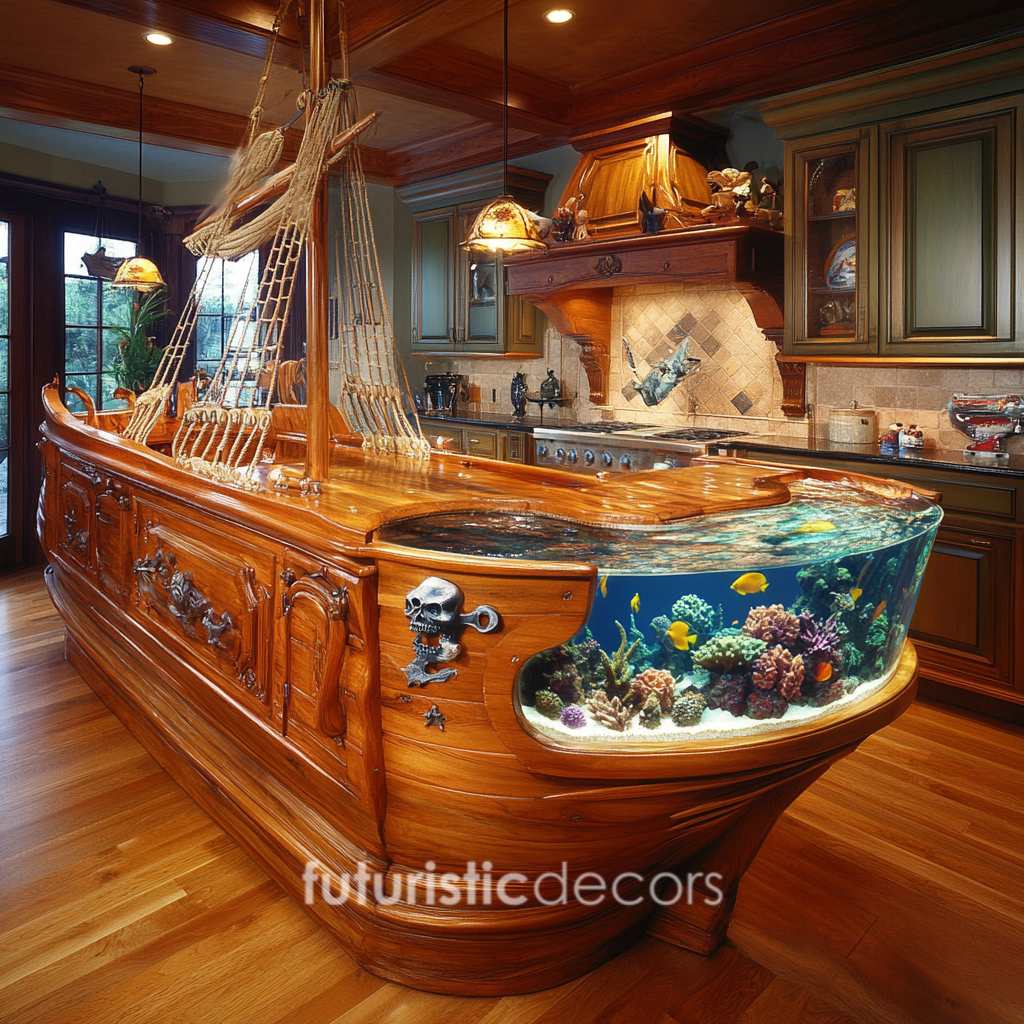
Customization Options
Personalizing your pirate ship aquarium island allows you to infuse individual flair:
LED Accent Lighting: Program color-cycling LEDs to evoke sunrise, high noon, or moonlit nights at sea.
Themed Hardware: Swap standard drawer pulls for miniature anchors, rope-knob handles, or skull-embossed brass fixtures.
Interactive Features: Install a small fog machine in a “cannon” prop to create misty sea breezes when you entertain.
Integrated Speakers: Conceal waterproof Bluetooth speakers in the mast or hull for ambient sea-shanty playlists.
Modular Attachments: Add detachable paddle shelves, spice-rack “oar” holders, or a fold-out treasure chest wine rack.
These enhancements let you tailor the island to your culinary habits, entertaining style, and personal aesthetic—ensuring your pirate ship is truly one of a kind.
Budgeting Considerations: Pirate Ship Aquarium Kitchen Island
A custom pirate ship aquarium kitchen island represents a significant investment. Key cost factors include:
Design & Engineering: $2,000–$5,000 for professional consultation, 3D renderings, and structural analyses.
Materials: $3,000–$7,000 for marine-grade plywood, hardwood veneers, epoxy coatings, and brass hardware.
Aquarium Components: $2,000–$5,000 for a 150-gallon acrylic tank, filtration system, lighting, and sensors.
Labor & Installation: $4,000–$8,000 for carpentry, plumbing, electrical work, and professional aquarium setup.
Customization Add-Ons: $500–$2,000 for LED programming, themed accessories, and specialty finishes.
Overall, expect total costs in the $12,000–$27,000 range, depending on size, materials, and customization level. Obtaining multiple quotes and phasing upgrades can help manage expenses, spreading costs over time.
Sustainability & Eco-Friendliness
Incorporate green practices to minimize environmental impact:
Responsibly Sourced Wood: Opt for FSC-certified plywood and veneers.
Energy-Efficient LEDs: Use low-wattage, long-life LED fixtures to reduce power consumption.
Low-Flow Filtration: Choose pumps and filters rated for high efficiency, lowering electricity use by up to 40%.
Recycled Materials: Some manufacturers offer recycled-glass countertop slabs and reclaimed-wood accents.
Native Aquatic Species: Stock freshwater islands with species indigenous to your region, reducing reliance on imported fish and mitigating biosecurity risks.
By prioritizing eco-friendly options during design and stocking, you create a kitchen centerpiece that’s as gentle on the planet as it is on the eyes.
Real-World Examples
Coastal California Condo
In La Jolla, a beachside condo owner installed a 120-gallon pirate ship aquarium kitchen island, using whitewashed wood and turquoise epoxy accents to mirror the Pacific’s hues. Blue tangs, clownfish, and anemones bring vibrant color beneath the galley’s butcher-block countertop, while a brass-ringed porthole doubles as a wine glass holder.
Mountain Retreat Lodge
At a rustic Rockies cabin, designers crafted a darker-oak island with copper rivets and weathered sails overhead. The freshwater tank houses native minnows and aquatic plants, creating a serene focal point that contrasts with stone countertops and wrought-iron fixtures.
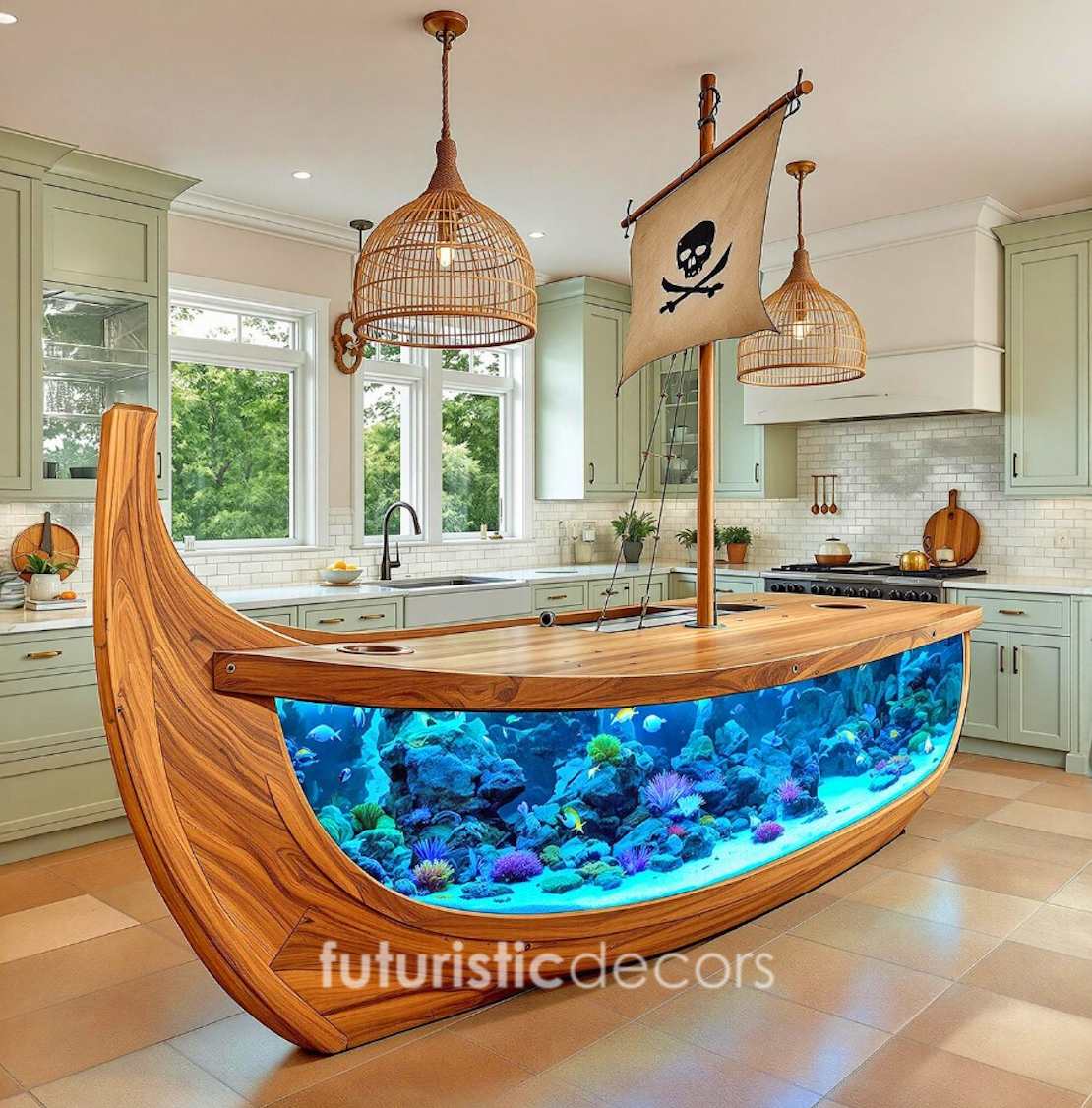
Urban Loft Restaurant
A trendy Brooklyn eatery features a pay-per-view private dining pod shaped like a pirate ship hull. Each booth includes a personal 40-gallon tank, complete with jellyfish and moonlights, offering diners an immersive, Instagram-worthy experience alongside gourmet small plates.
These installations demonstrate the versatility of the concept across styles—from coastal chic to industrial-rustic and commercial dining—proving that a pirate ship aquarium kitchen island can adapt to any setting.
Pros & Cons: Pirate Ship Aquarium Kitchen Island
Pros
Unique centerpiece that merges form and function
Calming ambiance from aquatic life
Efficient use of space
Customizable to any décor style
Cons
High initial investment and ongoing maintenance costs
Requires structural reinforcement
Potential safety considerations with water and electricity
Careful planning needed for workflow integration
Frequently Asked Questions
- What fish are best for a pirate ship aquarium?
Small, hardy species like clownfish, gobies, or neon tetras thrive in compact marine or freshwater ship-hull tanks. Choose community fish that tolerate gentle currents and aquarium lighting. Avoid large or aggressive species that may feel cramped beneath a confined kitchen island. - How often should I clean the aquarium?
Perform light glass cleaning and water-top-off daily, with weekly 10–15% water changes. Monthly, replace filter media and inspect seals. Every three months, conduct a deeper equipment cleanse—especially for pumps and intake strainers—to maintain optimal water quality. - Will the aquarium affect my kitchen workflow?
With thoughtful layout planning—keeping prep zones on one side and seating on the other—the aquarium rarely disrupts cooking. Hidden access panels allow maintenance without moving appliances. Adequate clearance ensures traffic flow around the island remains unobstructed. - How long does construction take?
From initial design to finishing touches, expect a timeline of 8–12 weeks. Custom fabrication often requires 4–6 weeks for hull and cabinetry build, 1–2 weeks for aquarium assembly and leak testing, and 2–4 weeks for installation and final décor touches. - Can I DIY this project?
DIY is possible for experienced woodworkers and aquarium hobbyists. However, structural reinforcement, waterproof sealing, and complex plumbing often warrant professional involvement. A hybrid approach—DIY exterior finishes with pro-installed aquarium components—strikes a balance between cost savings and reliability. - What are the ongoing costs?
Monthly expenses typically include electricity for lighting and pumps ($20–$50), filter media replacements ($10–$20), and fish food or salt mixes ($15–$30). Annual services—such as sensor calibration or professional cleanings—range from $200–$400, depending on system complexity.
Conclusion: “Pirate Ship Aquarium Kitchen Islands”
A Pirate ship aquarium kitchen island marries maritime romance with practical design, transforming your cooking space into an immersive, functional masterpiece. From the initial concept and structural considerations to choosing the right fish species and maintaining water quality, this guide has navigated every aspect of planning, building, and caring for your nautical culinary centerpiece.
Whether you’re seeking to wow guests, reduce stress with the calming presence of aquatic life, or simply maximize your kitchen’s aesthetic impact, the pirate ship aquarium island offers an unforgettable statement piece. By working with experienced designers, selecting high-quality materials, and committing to regular upkeep, you’ll ensure that your island remains a vibrant, conversation-worthy hub for years to come. Embark on this adventure today—and let your kitchen set sail on a voyage of creativity and culinary inspiration.


